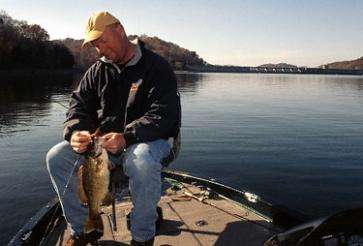
Everyone knows that bass have seasonal patterns and that there are times when they move from shallow water to deep water and back again, from the main lake to the creeks and coves. We expect these transitions, but few of us truly anticipate them or try to stay ahead of them. And that’s exactly what I want you to do on your favorite smallmouth waters.
Right now, as we’re getting into September, it’s still pretty warm over much of the country, but the days are getting shorter and it’s not hard to see (even if it is hard to feel) that summer will be ending soon.
That means it’s getting close to when we need to be thinking about fishing like it’s fall. Just because we’re not noticing all the signals out there doesn’t mean the bass aren’t noticing. They’re much more closely plugged into nature. After all, they live in it!
We sit in air conditioning all day, wear clothes that protect us from the elements and rarely go more than a few steps from our homes and offices to our cars and trucks. The bass are out there all the time and their primitive nervous systems are picking up all the cues.
So even though we think and feel that it’s still summer — and even though water temperatures have hardly budged from their summertime highs — some of the bass out there are already thinking about fall. And not only that … it’s some of the very biggest ones!
I’m not sure why it is, but it seems to me that some of the very biggest females are the earliest to react to things in nature. They’re the earliest to the spawning grounds, the earliest to deep water in the summer and the earliest to the creeks in the fall. Maybe they’re just more in tune with nature and the shad migrations that move up in search of plankton. It makes sense to me, though, that the biggest, most successful members of the species are also the most in tune.
This is the time of year — before the heat really breaks — you’ll find me checking out the creeks in highland reservoirs and looking for those early lunkers. I won’t usually spend an entire day looking at this point, but I like to check out a few creeks and some shallow water (5 to 10 feet) before heading back out to the main lake and their summertime holding areas.
My favorite bait at this time for this pattern is a 3/16-ounce shaky head jig with a 4-inch Go To Bait Co. worm in pumpkin pepper. I throw it on a spinning outfit and 8-pound line. It’s not a fast way of fishing, but it’ll catch bass of all sizes, and I have a lot of confidence in it.
If I’m out at night (and you can catch smallmouth at night all year long), I like to fish a 3/4-ounce black and blue Punisher spinnerbait with a big blue blade. I throw it on casting tackle and 12-pound line. The best retrieve is just to slow roll it around the points and drops. If something’s there, the fish will just about take the rod out of your hands.
So if you’re waiting for the weather to break before you start working your favorite fall spots, you just might find that the bass have beaten you there.
Until next time, if you have any questions or comments, I’d love to hear from you. Please e-mail me at Stephen@thesmallmouthguru.com.
Slower is better

